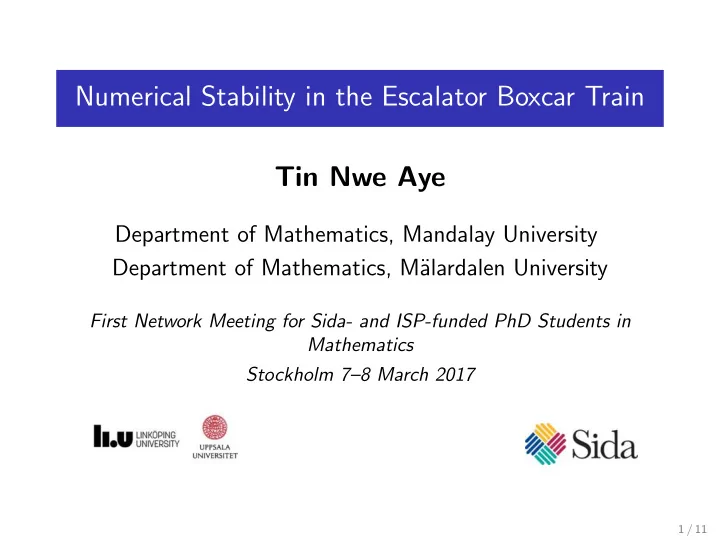

Numerical Stability in the Escalator Boxcar Train Tin Nwe Aye Department of Mathematics, Mandalay University Department of Mathematics, M¨ alardalen University First Network Meeting for Sida- and ISP-funded PhD Students in Mathematics Stockholm 7–8 March 2017 1 / 11
My Advisors Sergei Silvestrov Linus Carlsson Khin Phyu Phyu Htoo Main advisor Assistant advisor Assistant advisor M¨ alardalen University M¨ alardalen University Mandalay University 2 / 11
Introduction In mathematical biology, there is often a need to study physiological structured population models. Physiologically structured population models(PSPMs) describes the dynamics of an arbitrary number of biological populations. Examples include models of fishes in lakes and trees in forests. PSPMs investigate the study of change in populations in which individuals differ physiologically in one or more ways, e.g., in their size. 3 / 11
For the dynamics of PSPMs, we assume that the density n ( x , t ) of individuals of state x at time t are defined by ∂ t n ( x , t ) + ∂ ∂ ∂ x g ( x , E t ) n ( x , t ) = − µ ( x , E t ) n ( x , t ) � ∞ g ( x b , E t ) n ( x b , t ) = b ( x , E t ) n ( x , t ) dx x b n ( x , 0) = n 0 ( x ) Here, g is the growth rate, µ is the mortality rate, and b is the fecundity rate. 4 / 11
5 / 11
Escalator Boxcar Train(EBT) One way to study the dynamics of a PSPMs numerically, the structured population has to be subdivided into distinct groups of individuals that are more or less similar which are called cohorts. The cohorts clarify internal cohorts and boundary cohorts because of newborns population. The new born individuals are assumed to have the same physiological properties and are accumulated in the boundary cohorts. The number of individuals in the i th cohort is denoted by N i ( t ) and the mean individual state will be used and denoted as X i ( t ). 6 / 11
The dynamics of the internal cohorts are defined by dN i dt = − µ ( X i , E ) N i dX i dt = g ( X i , E ) where E is the environmental feedback. Similarly, the dynamics of the boundary cohorts for the reproduction case follow M dN B � = − µ ( X B , E ) N B + b ( X i , E ) N i dt i = B dX B = g ( X B , E ) dt 7 / 11
Simulation of the EBT and Daphnia model Daphnia pulex is a species of the Daphnia Daphnia is known as the waterflea because of its unque swimming style. Larger individuals have higher food consumption, basal metabolism and reproduction rate The mature Daphnia have a fixed size Daphnia individuals can shrink under particular conditions 8 / 11
The EBT of the Daphnia’s life model will be simulated using MATLAB. MATLAB is an interactive program widely used in mathematics. The program can be made for numerical computation and works fast. MATLAB is selected to be used for this project and the function ode45 is chosen to solve the ODEs because of its high accuracy. 9 / 11
Planned Research Project For solving the above partial differential equation, we need to solve the problem numerically since a general analytical solution does not exist. One of the most popular model is the Escalator Boxcar Train(EBT) which is a numerical method to find solutions to PSPMs. Computational disadvantages of the EBT method include, e.g., increasement of ode’s over time, the trajectories of the cohorts converge or diverge over time, internal cohorts may have an inefficient number of individuals. We aim to built an EBT-solver to overcome these problems which includes the automatic feature of merging and splitting the cohorts. 10 / 11
Tack s˚ a mycket! Thank you! 11 / 11
Recommend
More recommend